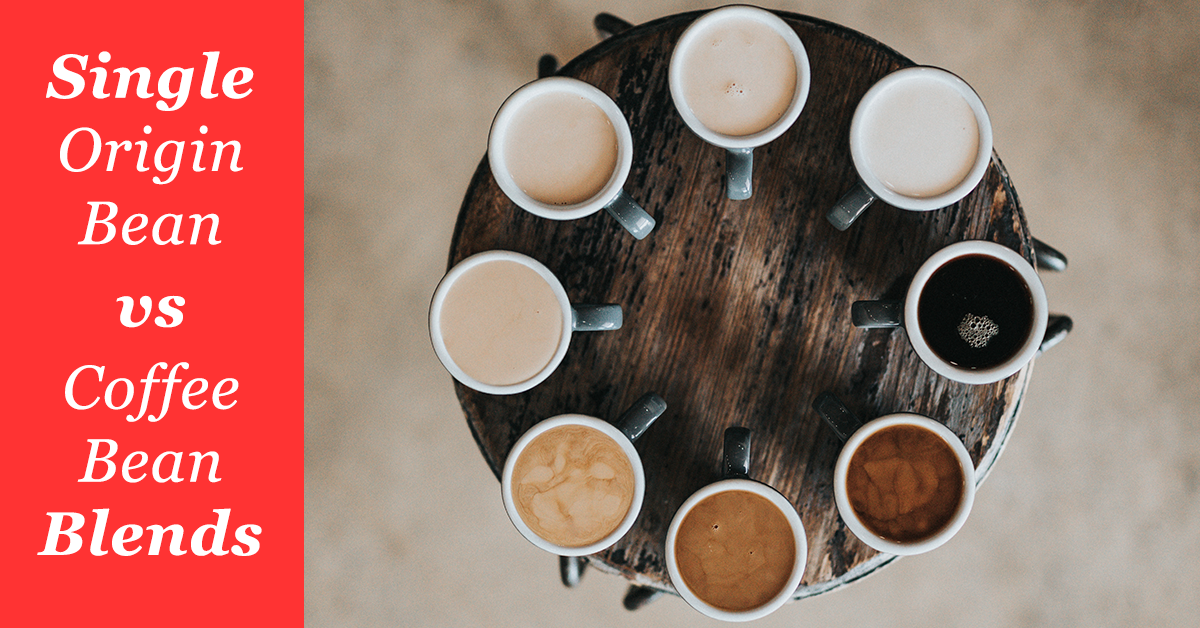
Single Origin Beans vs Coffee Bean Blends
The rise in availability of high quality single origin coffees in coffee shops and on-line retailers has prompted coffee fans to examine the relative virtues of single origin coffees verses blends. In our opinion, one option is not better than the other. It’s entirely down to what you are looking for in a coffee.
The Virtues of Single Origin Coffee
A single origin coffee is a bag of beans which all originate from the same region, cooperative or farm. These “micro lot” beans typically have a distinctive flavour based on the area in which they’re grown, and this is heavily influenced by the soil, climate, altitude, shade levels, along with many other factors. A blend is created by mixing coffee beans from different locations around the world.
Those who advocate for single origin coffee extol the enjoyment found in savouring the subtle, crisp and often fruity flavours of each coffee. They also herald the growing interest in traceability, whereby consumers can learn about the specific cooperative, farm and even field where the coffee was grown, helping them relate more to the product and appreciate the finer nuances of its taste.
An increase in the demand for high-quality specialist coffee has led to improvements in the overall production and supply chain process in the industry. This, in turn, has meant coffees from a single origin source have become more reliable in their quality and flavour, making them a more viable choice for consumers.
As a general rule of thumb, single origin coffee isn’t suitable for espresso because it needs a combination of sweetness, acidity, and crema… which one source usually cannot offer. Instead, brewing methods such as pour-over, Chemex or AeroPress, are more suitable in extracting the delicate intricacies of single origin coffees.
When trying single origin coffee, take the following into consideration:
+ Source light roasted beans as they preserve more of the bean's flavour than dark roasts.
+ Brew correctly in order to extract as much of the flavouring notes as possible (see our Brewing Basics for details: https://www.spillerandtait.co.uk/pages/brewing-principles).
+ Keep your coffee black (milk and sugar free) to fully appreciate the coffee's true taste and aroma.
+ Enjoy the personal connection and stories from the bean's origin and producers.
The Virtues of Blended Coffee
Although blends typically create a well-rounded, smooth and full bodied taste, coffee roasters also create blends because: they spread supply and quality-related risks; they improve consistencies over different seasons; and sometimes they disguise older or less popular beans with higher quality beans.
Coffee beans are normally blended after roasting, but some are combined when the beans are still green. Creating coffee blends is a skilled art. When you mix two type of beans with distinctive qualities, it doesn’t mean the resulting blend will exhibit a combination of the two. As you might expect, if the two qualities don’t go well, it’ll have a detrimental effect. Similarly, the results will be exponentially better if the varying qualities of the beans used supplement one another.
As such, creating successful coffee blends is a complicated proposition where a roaster must consider and balance the following factors: acidity, solubility, initial taste, and aftertaste. For example, a roaster must go through an in-depth trial and error process to find the perfect balance between one type of bean that’s more bitter and the other one that’s sweeter.
Primarily, blended coffee is all about the consistency. Although there isn’t a fixed formula, there is usually a closely guarded base recipe used to create the standard taste. As the crops change from season to season, the exact formula will be altered so that the end results remain roughly the same.
The versatility of blended coffee means they can also be blended and roasted to suit a particular brewing method, and these days most good roasters will advise on the suitability of their blend for a particular device. Therefore, the choice between single source or blend is normally between strength of flavour and body, over subtlety and story. However, if you enjoy your coffee as a milk-based drink, then you will normally need a blend, where the intensity and richness of flavour works well as an espresso shot which can be discerned through the milk.
Overall, there are times when you may be compelled to try micro-lot coffee from a good roaster. Other times, you might just prefer to go for a reliable, well-established blend that you know and love. As such, at Spiller & Tait we don’t focus on whether single-sourced or blended coffee wins, we say enjoy each for different reasons. But, what we do know about our customers is that, at the moment, most prefer blends and that’s why most of our coffees are of this variety.


